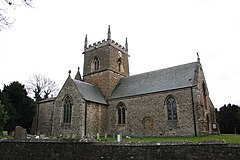
Summary
Riby is a village and civil parish in the West Lindsey district of Lincolnshire, England. The population of the civil parish was 129 at the 2011 census.[1] It is situated approximately 4 miles (6 km) south-west from the town of Grimsby.
| Riby | |
|---|---|
 St Edmund's Church, Riby | |
 Riby Location within Lincolnshire | |
| Population | 129 (2011) |
| OS grid reference | TA184075 |
| • London | 140 mi (230 km) S |
| District | |
| Shire county | |
| Region | |
| Country | England |
| Sovereign state | United Kingdom |
| Post town | Grimsby |
| Postcode district | DN37 |
| Police | Lincolnshire |
| Fire | Lincolnshire |
| Ambulance | East Midlands |
| UK Parliament | |
History edit
There are two scheduled barrows 700 yards (640 m) south-west of Riby Grove Farm. Whilst they are no longer visible above ground, the burial remains survive inside. One is a Neolithic long barrow, and the other a Bronze Age bowl barrow.[2]
A hoard of 15–20,000 bronze coins dating from Gallienus to Aurelian (AD 253–275) were found in an urn covered by a dish at Riby Wold Farm in 1953. The coins are held by the Ashmolean Museum pending classification.[3] Lincoln Museum hold a further collection of 21 coins, Constantine - Gratian (AD 305–383), thought to be only part of a hoard found at Riby.[4]
The parish church is a Grade II* listed building dedicated to Saint Edmund and dating from the 12th century with an 1868 restoration by Ferrey, and built from limestone and ironstone. The west door is late 13th-century, and there is a blocked 12th-century door in the north aisle. The east window records that George Tomline funded the restoration, and there are several memorials to the Tomline family in the church.[5]
On 18 June 1645, there was a civil war clash at Riby Gapp, and the parish register of Riby contains the following entries:[6]
"Nine soldiers slaine in a skirmish in the field of Riby the day before, buried June the 19th."
"Charles Skelton, a soldiour wounded in the same skirmish, buried June the 20th."
"William Willoughbie a soldier wounded in the skirmish above named, buried July the 4th"
Riby Grove was a country house, now demolished, which stood in the village. In 1803 Marmaduke Tomline, owner of the Riby Grove, bequeathed the house and estate to George Pretyman, the Bishop of Lincoln, on condition that he adopted the name Tomline. Pretyman accepted the inheritance and thereafter adopted the name Pretyman-Tomline. His son William Edward Pretyman Tomline was born at Riby in 1787 and became a Member of Parliament and High Sheriff of Lincolnshire for 1824–25. He in turn had a son "Colonel" George Tomline, also a Member of Parliament and High Sheriff of Lincolnshire in 1852. The house was demolished in 1935.
Riby School was built in 1890 as Riby National school, replacing a village school built in 1848 by the Tomline family. It was known as Riby County School by 1947 and closed in 1958.[7]
Notable people edit
Riby is the birthplace of the fashion model and photographer Jill Kennington.[8]
References edit
- ^ "Civil Parish population 2011". Neighbourhood Statistics. Office for National Statistics. Retrieved 27 May 2016.
- ^ Historic England. "Scheduled Barrows at Riby (1018838)". National Heritage List for England. Retrieved 17 July 2011.
- ^ Historic England. "Coins found at Riby (80244)". Research records (formerly PastScape). Retrieved 17 July 2011.
- ^ Historic England. "Coins found at Riby (80251)". Research records (formerly PastScape). Retrieved 17 July 2011.
- ^ Historic England. "St Edmunds church, Riby (1146937)". National Heritage List for England. Retrieved 17 July 2011.
- ^ William White (1856). Notes and Queries, Vol 13. Oxford University Press. p. 272. Retrieved 17 July 2011.
- ^ "Riby School". Lincs to the Past. Lincolnshire Archives. Retrieved 17 July 2011.
- ^ "Jill Kennington". FirmSites Blank Unit. Retrieved 28 August 2014.
External links edit
- Media related to Riby at Wikimedia Commons


